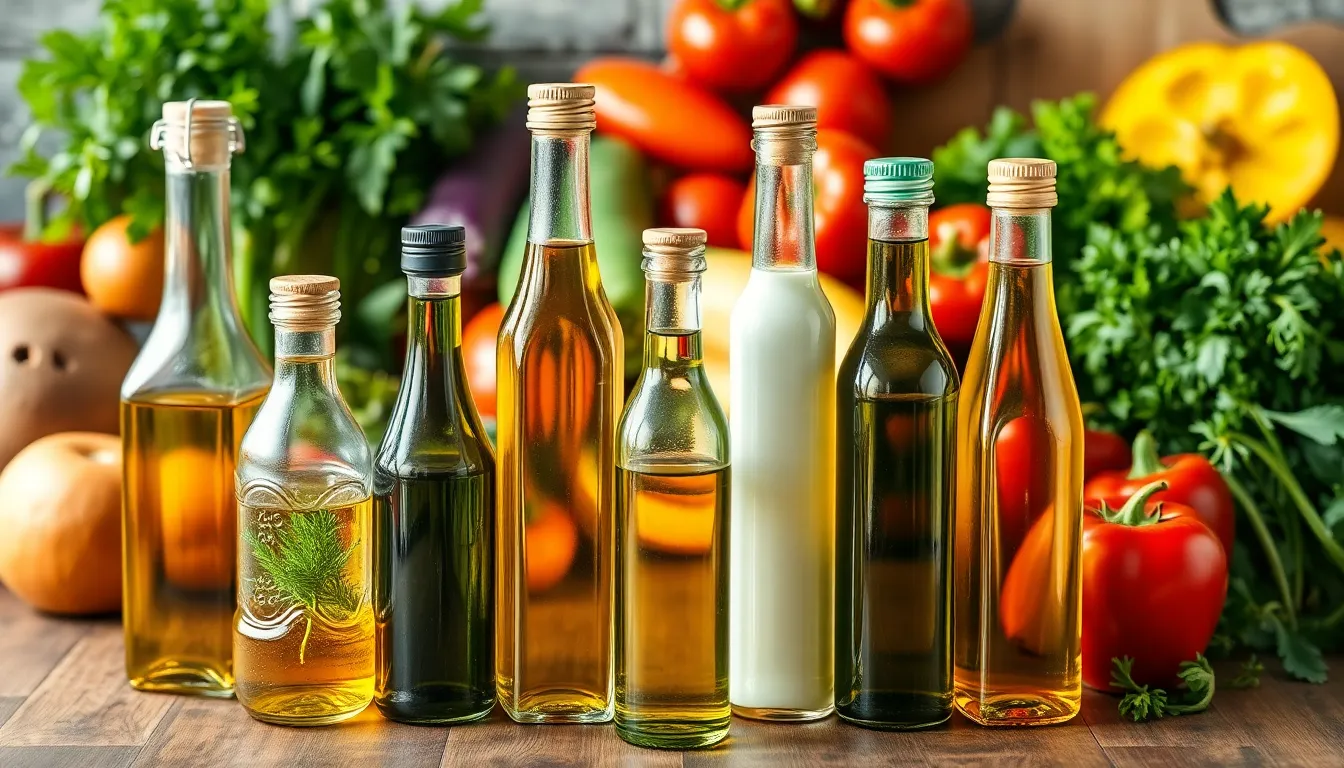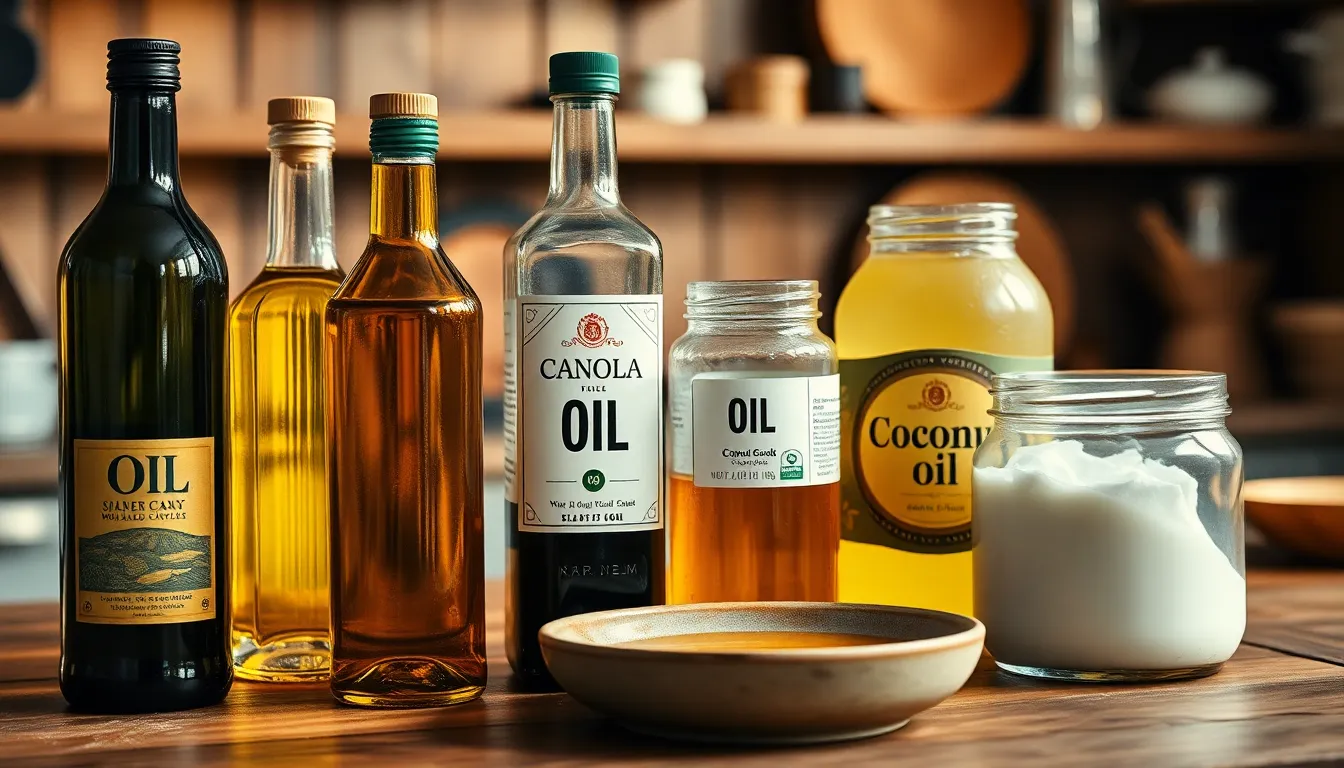Cooking oil is a staple in kitchens around the world, but many people wonder about its shelf life. Does cooking oil really go bad? Understanding the longevity of cooking oil is crucial for both safety and flavor in culinary creations.
Over time, exposure to light, heat, and air can cause oils to degrade, leading to off-flavors and potential health risks. Knowing how to store oils properly and recognizing signs of spoilage can help home cooks make the most of their ingredients. With a little knowledge, anyone can ensure their cooking oil remains fresh and ready for use.
Table of Contents
ToggleUnderstanding Cooking Oil
Cooking oil consists of various types and serves multiple purposes in the kitchen. Knowing the characteristics of each type can enhance cooking techniques and maintain flavor integrity.
Types of Cooking Oil
- Olive Oil: Olive oil, primarily used in Mediterranean cooking, contains healthy fats and antioxidants. Extra virgin olive oil has a higher quality and distinct flavor.
- Canola Oil: Canola oil, derived from rapeseed, features a mild flavor and high smoke point, making it suitable for frying and baking.
- Vegetable Oil: Vegetable oil contains a blend of different oils, commonly soybean or corn oil. It’s versatile and widely used for frying and sautéing.
- Coconut Oil: Coconut oil has a unique flavor and is solid at room temperature. It’s popular in baking and can withstand high heat due to its high saturated fat content.
- Sesame Oil: Sesame oil, often used in Asian cuisine, has a nutty flavor and is available in both light and toasted varieties, each offering distinct culinary benefits.
Common Uses of Cooking Oil
- Frying: Oils with high smoke points like canola and vegetable oil are ideal for deep frying due to their ability to withstand heat without burning.
- Sautéing: Olive oil and coconut oil provide excellent options for sautéing vegetables, enhancing flavors while maintaining nutritional value.
- Dressings: Oils such as olive oil serve as a base for dressings and marinades, adding depth and richness to salads and other dishes.
- Baking: Certain oils, including canola and coconut oil, contribute moisture and texture to baked goods.
- Flavoring: Specialty oils, like sesame oil, enhance dishes with their distinctive flavors, elevating the overall culinary experience.
Does Cooking Oil Go Bad?

Cooking oil can go bad due to various factors. Recognizing spoilage signs and understanding shelf life can help maintain both safety and quality.
Signs of Spoiled Cooking Oil
- Smell: Rancid oil emits a strong, unpleasant odor. Fresh oil should have a neutral or light scent.
- Appearance: Cloudiness or sediment indicates contamination or spoilage. Fresh oil typically appears clear and bright.
- Flavor: Off-flavors can signal that oil has gone bad. A bitter or stale taste is a clear sign of deterioration.
- Texture: Thickening or stickiness in oil can suggest spoilage. Fresh oil maintains a smooth consistency.
Factors Affecting Shelf Life
- Type of Oil: Different oils have varying shelf lives. For instance, olive oil generally lasts 18 months, while coconut oil can extend up to 24 months.
- Storage Conditions: Heat, light, and air exposure significantly shorten shelf life. Storing oils in a cool, dark place in tightly sealed containers prolongs freshness.
- Processing Method: Refined oils typically last longer than unrefined oils. Unrefined oils contain more impurities, which can accelerate spoilage.
- Expiration Dates: Manufacturers provide best-by dates, indicating peak freshness. Utilizing oils before these dates ensures optimal flavor and safety.
Storing Cooking Oil Properly
Storing cooking oil properly preserves its quality and extends its shelf life. Following the right practices ensures that oils remain fresh and safe for cooking.
Ideal Storage Conditions
Cooking oil thrives in cool, dark places. Temperature stability plays a crucial role; a pantry or cabinet away from heat sources is best. Avoid locations near stoves or ovens where heat can fluctuate. Light exposure degrades oil quickly, so opaque or dark glass containers provide an excellent barrier. Sealing oils with airtight lids prevents air ingress, which reduces oxidation and spoilage.
Tips for Extending Shelf Life
- Keep oils away from light: Storing in a dark place keeps oils fresher longer.
- Seal containers tightly: An airtight seal minimizes exposure to air and humidity.
- Use smaller bottles: Purchasing in smaller quantities avoids prolonged exposure after opening.
- Refrigerate when necessary: Some oils, particularly nut oils or those without preservatives, benefit from refrigeration.
- Check expiration dates: Always monitor dates on labels to use oils within their shelf life.
- Avoid cross-contamination: Use clean utensils to prevent introducing bacteria into oil containers.
Implementing these storage practices keeps cooking oil in optimal condition, allowing for enhanced flavor and safety in culinary applications.
Best Practices for Using Cooking Oil
Maintaining the quality of cooking oil is crucial for safety and flavor. Employing simple testing techniques and understanding when to discard oil helps ensure optimal use.
How to Test for Freshness
Testing cooking oil freshness can be straightforward. Home cooks can follow these steps:
- Smell the oil: Rancid oil emits a distinct, unpleasant odor. Fresh oil has a neutral or pleasant scent.
- Examine clarity: Fresh oil appears clear. Any cloudiness or visible sediment indicates potential spoilage.
- Taste a small amount: Fresh oil tastes smooth and pleasant. Off-flavors signify the oil has degraded.
Conducting these tests periodically helps ensure the oil’s safety and quality.
When to Discard Cooking Oil
Knowing when to discard cooking oil is essential for health and flavor. The following guidelines indicate spoilage:
- Rancid smell: If oil smells off or has a strong, rancid scent, discard it immediately.
- Cloudiness or sediment: Visible particles or cloudiness suggests oil has gone bad and should be thrown away.
- Expiration date: Always check the manufacturer’s expiration date. If it has passed, replace the oil.
- Changes in texture: If oil feels sticky or unusually thick, it’s best to discard it.
Following these guidelines ensures home cooks maintain a safe and flavorful cooking experience.
Cooking oil plays a crucial role in the kitchen and understanding its shelf life is essential for both safety and flavor. By recognizing spoilage signs and adhering to proper storage practices, home cooks can ensure their oils remain fresh and effective for culinary use.
Taking the time to test oil for freshness and being mindful of storage conditions will not only enhance cooking experiences but also contribute to healthier meals. With the right knowledge and practices, it’s possible to enjoy the benefits of cooking oil while minimizing waste and maximizing flavor.




